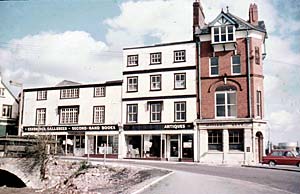
New Bridge Street
Page updated 16 May 2009
 A start was made in 1770 to
build a new Exe bridge
and a new approach road from the city. In 1775, a huge flood destroyed
the part complete works, and a second
start was made on the new bridge which was eventually completed in 1778.
A start was made in 1770 to
build a new Exe bridge
and a new approach road from the city. In 1775, a huge flood destroyed
the part complete works, and a second
start was made on the new bridge which was eventually completed in 1778.
It was decided that a direct link from the new bridge to Fore Street would be preferable to the old route through the West Gate, and a viaduct from Fore Street, cutting Exe Island in two was constructed. There was an arched tunnel under the New Bridge Street linking Exe Island with Frog Street. Other openings were made through the viaduct, for the Upper and Lower Leats to flow.
The church of All-Hallows-on-the- Wall, at the bottom of Fore Street, that had been left semi-derelict after being badly damaged during the Civil War, was removed to allow New Bridge Street to join Fore Street.
The leats provided an obstacle to the building of New Bridge Street, and Jenkins noted in 1805:
"In some places it was necessary to elevate the ground near forty feet, in order to form a level; and arches were turned over the mill leats and avenues into the Island and Bonhay. At the bottom of Fore-street, directly in the way of the intended opening, stood the tower and remains of the parish church of St. Hallows on the Walls, which was taken down " (Jenkins)
Business in New Bridge Street
Westlake Brothers was a prominant grocers shop in the 19th-Century. They were also tea importers and would be heavily promoted every Christmas for their fuits and novelties. The street had a variety of businesses at the time, including cordwainers (shoe shops), bakers, a wine and spirit vaults and several butchers, including John Melhuish. The City Saw and Turning Mills of W Linscott, who manufactured bedsteads were also located in the street.
These are a few of the businesses remembered by James Cossins in New Bridge Street from about 1820:
"BRIDGE STREET. Pates, tailor : Bull, glassblower : Street, druggist : Paul, broker : Pyne, babylinen : Williams, barber : Page, spirit dealer : Stone, bookseller : Marks, brushmaker : Dale, hairdresser: Pinkstone, grocer: Hemmens, Round Tree Mills: Worthy, 13 factory : Pinhey, brewer : Dymond, seed shop : Dymond, draper : White, Pinhey, and Daw, City Brewery."
Mr Cornish ran a slaughter-house in New Bridge Street, and in 1877 it was inspected, following a complaint. It was noted, that on the day of the complaint, a large number of cattle were slaughtered, and when the task was complete, everything had been cleared away satisfactorily.
The Exe Island Mission Hall, below New Bridge Street in Exe Island, had a covered footbridge from the top floor of the mission into New Bridge Street. The link and doorway is still there. It has been referred to as the coffin entrance to the mission.
The Round Tree Mill, was situated on the lower leat; the building butted against the New Bridge Street viaduct, with an entrance from the street. The inn was mentioned as early as 1727 as the Cuckinstool Mill, in an advert in Brice's Weekly, and ceased trading in 1903. It suffered three fires within a short space of time, the third of which destroyed it in 1910.
The Star and Garter opened as a beer house around about 1863 with James Stoneman as landlord. It was popular with farmers and workers at the cattle market, situated, as it was, on the corner of New Bridge Street and Bonhay Road. It was closed in 1929, and demolished in 1933 for road widening.
The modern New Bridge Street is a shadow of its former self, since the building of the twin Exe crossings in the 1960's and 70's, and the demolition of many of the buildings at the lower end of the street for the Frog Street underpass. The first building on the left as you enter New Bridge Street has the Westgate Festival Mural painted on its end wall. It was painted in 1979 by Andrew Stacey to celebrate the Westgate Festival.
 New Bridge Street from Bonhay Road - the Exe Bridge leads off to
the right - circa 1960. Photo courtesy of Alan H Mazonowicz.
New Bridge Street from Bonhay Road - the Exe Bridge leads off to
the right - circa 1960. Photo courtesy of Alan H Mazonowicz. The entrance to the Mission Hall
on Exe Island from New Bridge Street. Photo Express and Echo
The entrance to the Mission Hall
on Exe Island from New Bridge Street. Photo Express and Echo
│ Top of Page │